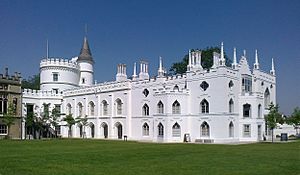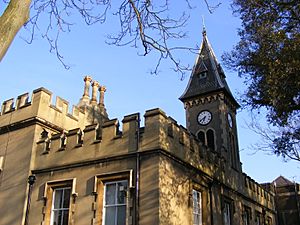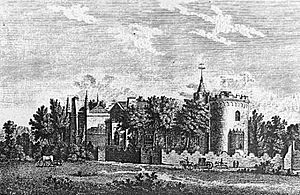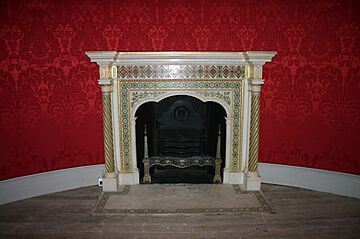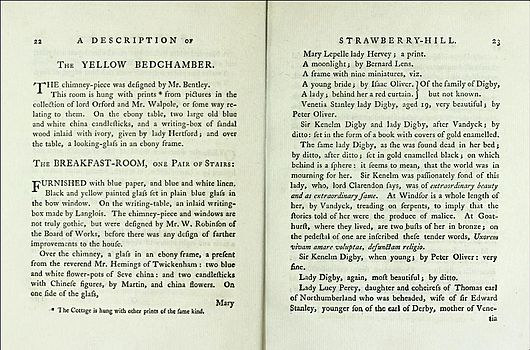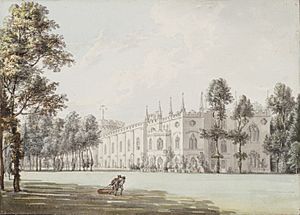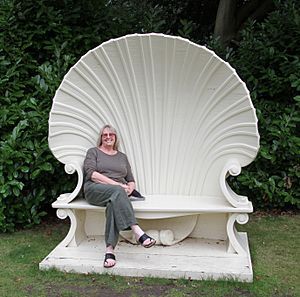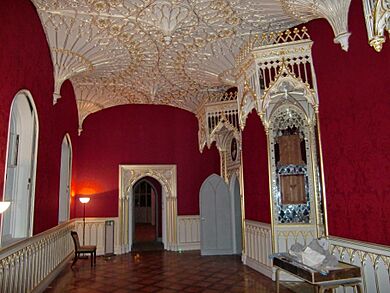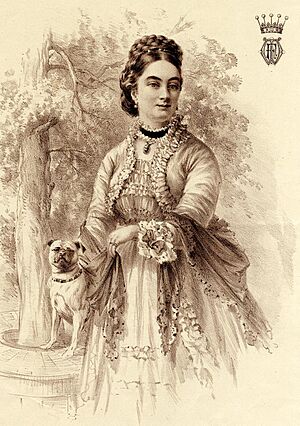Strawberry Hill House facts for kids
Strawberry Hill House, also known as Strawberry Hill, is a famous old house in Twickenham, London. It was built by Horace Walpole (1717–1797) starting in 1749. This house is special because it was one of the first buildings designed in the "Gothic Revival" style. This means it looked like old medieval castles and cathedrals.
Walpole changed the house over many years, adding towers, battlements, and fancy decorations. He wanted the inside to feel a bit mysterious, a style he called "gloomth." This feeling matched his collection of old and interesting objects. The gardens, however, were designed to be bright and cheerful. The house also features a special fireplace designed by Robert Adam and parts of the outside were planned by James Essex. In the garden, there was a large seat shaped like a seashell, which was rebuilt during a restoration in 2012.
Contents
Horace Walpole's Vision
Buying and Planning the House
In 1747, Horace Walpole rented a small house in Twickenham. It was like a cottage with a few acres of land. He felt he needed a country home, especially a "family castle," which was popular then. The next year, he bought the house. Its original name was "Chopped Straw Hall," which Walpole didn't like. He found an old document that called the land "Strawberry Hill Shot." So, he decided to name his new home "Strawberry Hill."
Walpole rebuilt the house step by step, making it look Gothic. He also bought more land, expanding his property. Strawberry Hill was important because it was one of the first houses built in the Gothic style from scratch. It used real historical examples for its design.
Walpole worked with two friends, John Chute and Richard Bentley. They called themselves the "Committee of Taste." They helped him plan the changes to the house. John Chute designed much of the outside and some inside parts. Walpole respected his ideas greatly.
Building the Gothic Castle
Walpole's house grew without a fixed plan. He added features as he thought of them. Outside, he added different towers and battlements. The house looked unique with its uneven shape and interesting outline.
Inside, Walpole added many decorative touches. These included grand gilded ceilings and large fireplaces. He also added smaller details like carved door handles and coats of arms. The first part of his "little Gothic castle" was finished by 1753. More changes happened in the 1760s and 1770s. A professional architect, James Essex, helped with the "Beauclerk Tower" in 1776. The whole project cost a lot of money for that time.
Inside the House and His Collection
Walpole's unique style continued inside Strawberry Hill. The house is said to have inspired his famous book, The Castle of Otranto. However, the rooms at Strawberry Hill were actually light and elegant, not dark like the book.
The rooms were designed to show off Walpole's collection of interesting old objects. He even published two books about his collection. These books, called A Description of the Villa of Mr. Horace Walpole at Strawberry Hill, told everyone about his treasures.
His collection was a very important part of the house's look and feel. Even without the objects, the house still feels like a "fairy-tale palace." Today, many items from Horace Walpole's collection can still be seen. Yale University has a special database that lists all the art and objects from his collection.
Designing the Gardens
Walpole was very careful when designing his gardens, just like he was with his house. He started working on the grounds even before the house was finished. In an essay called On Modern Gardening, Walpole shared his ideas about gardens. He preferred natural-looking gardens over the formal, symmetrical styles popular in France and Italy.
Walpole believed that trees and bushes should be planted in natural groups on the lawn. He wanted nature to feel like a garden. He did not like overly dramatic features like "romantic grottoes." He felt that while his house should have a "gloomth" (mysterious) feel, his garden should be "riant" (cheerful).
Walpole thought English gardens were perfect. He believed they showed the world how to soften nature's harshness and copy its beauty. He followed the ideas of William Kent, who helped create the English landscape garden style. The gardens at Strawberry Hill are now protected as a historic site.
The Shell Bench
One special feature in Walpole's gardens was a seat shaped like a giant sea shell. This "shell" was one of Walpole's favorite ideas. It was placed where he and his guests could see the river and the landscape.
Only two drawings of the original bench still exist. However, the garden has been restored to look as it did in Walpole's time. The amazing Shell Bench has been rebuilt for visitors to enjoy today.
Visitors to Strawberry Hill
Even when Walpole was alive, many people came to see Strawberry Hill. They admired the house, the gardens, and Walpole's collection. The house became famous throughout the country. Important people, including royalty, visited Strawberry Hill. Many regular sightseers also came.
Walpole enjoyed sharing his home, but the constant stream of visitors sometimes bothered him. He would give tours to important guests. But for others, his housekeeper would show them around, and Walpole would sometimes hide in his small garden cottage.
In a letter, Walpole joked that his house was like an "inn" because so many people visited. He said he spent all his time giving out tickets to see it or hiding. However, he also realized that his home brought joy to many people.
Important Dates for Horace Walpole
Here are some key dates in Horace Walpole's life related to Strawberry Hill:
- 1739 – He travels through France and Italy.
- 1745 – His father dies, and he inherits money and a house.
- 1747 – He finds and rents Strawberry Hill.
- 1749 – He buys Strawberry Hill.
- 1750 – He forms the "Committee on Taste" to plan the Gothic changes.
- 1753 – The first part of the building is finished.
- 1757 – He sets up his own printing press at Strawberry Hill.
- 1764 – His famous book, The Castle of Otranto, is published.
- 1774 – He prints A Description of the Villa of Mr. Horace Walpole.
- 1784 – He prints an updated version of his description book.
Later Owners of Strawberry Hill
After Walpole passed away, the house was passed down through his family. In the early 1800s, two brothers who owned the house spent most of their family's money. This led to a huge "Great Sale" in 1842. Almost everything inside the house was sold off.
In 1846, Frances Waldegrave, the wife of one of the brothers, inherited Strawberry Hill. She decided to restore the house in 1856. She made many changes, like moving the road and adding stained glass. She also decorated the ceilings and niches with gold designs. She brought the house back to life and became a famous hostess there. She sometimes felt that visitors gave all the credit to Walpole, even though she had worked so hard.
From 1883 to 1887, a banker named Baron Hermann de Stern owned the property. In 1923, St Mary's University College bought the house. It is still part of the university today.
Strawberry Hill Today
Restoring the House
In 2004, Strawberry Hill was featured on a TV show called Restoration. In 2007, a group called the Strawberry Hill Trust took over the house. Their goal was to restore it and open it to the public.
A special exhibition of Horace Walpole's collection was held at the Victoria & Albert Museum in London from March to July 2010. This helped prepare for the house's public opening. Experts saw Walpole as a very important person in both collecting and architecture.
After a big restoration project that cost £9 million and took two years, Strawberry Hill House reopened to the public on October 2, 2010. In 2013, Strawberry Hill House won a special award for cultural heritage. The Walpole Trust reopened the house to visitors again on March 1, 2015.
Lost Treasures of Strawberry Hill Exhibition
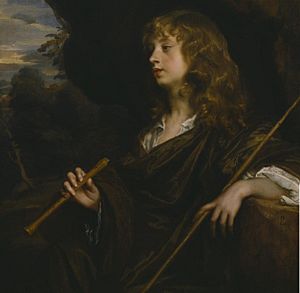
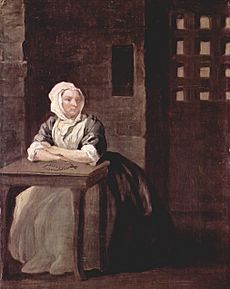
Between October 2018 and February 2019, about 150 artworks from Horace Walpole's collection were brought back to the house. These items had been sold in 1842 and were found in museums and private collections worldwide. They were placed back in their exact spots in Strawberry Hill House, just as Walpole had planned.
Some objects in the exhibition showed Walpole's interest in mysterious or "gothic" items. For example, there was a clock that Henry VIII gave to his wife Anne Boleyn, who was later executed. Another item was a 500-year-old red hat that Walpole believed belonged to Cardinal Wolsey. A painting by William Hogarth from 1733, showing a person in prison known for a serious crime, was also considered very "gothic."
Strawberry Hill Gothic Style
The "Strawberry Hill Gothic" architectural style became popular for a short time. However, some experts say that this term doesn't perfectly describe all Gothic buildings from that period. They argue that many houses called "Strawberry Hill Gothic" look quite different from Strawberry Hill House itself.
Some houses that were supposedly built or changed in this style include:
- Braziers Park, a country house in Oxfordshire, which was updated in 1799.
- Chalfont Park in Buckinghamshire, rebuilt in 1760.
- Donnington Park in Berkshire, designed in 1763.
- Houghton Lodge in Hampshire, built around 1800.
- Lee Priory in Kent, built between 1780 and 1790, but later destroyed.
- Priory Hospital in Roehampton, which was built in 1811 in the Strawberry Hill Gothic style.
See also
 In Spanish: Strawberry Hill House para niños
In Spanish: Strawberry Hill House para niños


